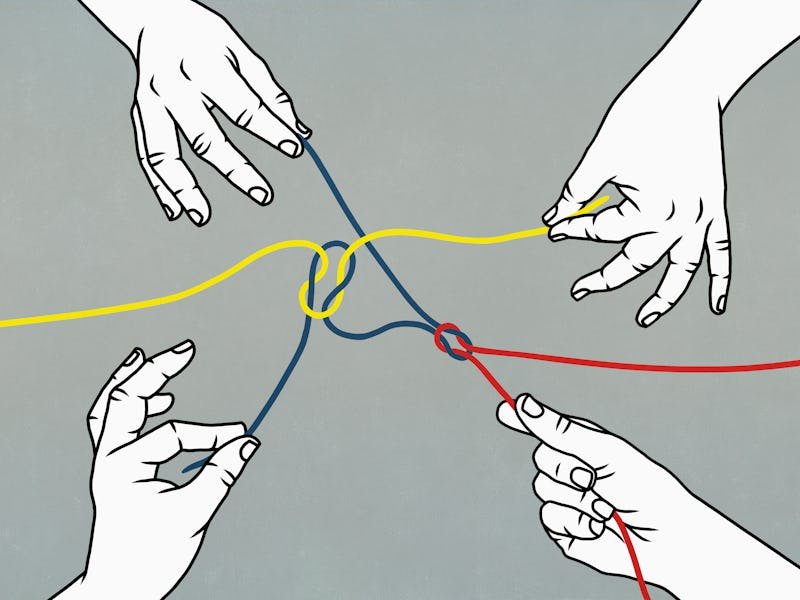An entrepreneur's 5-step guide to fostering teamwork in a remote workplace
The founder of Phone Loops shares his tips for encouraging employees to work together toward a common goal.

Jean-Philippe Brousseau, like many other entrepreneurs, started his business to solve a problem. In this case, it was the “very costly and annoying problem” of breaking his smartphone.
In 2014, he started Phone Loops, and business has been good, growing exponentially every year since, Brousseau said. The company has many corporate customers, including Microsoft, Adobe, The New York Times, L'Oréal, Caterpillar, Airbnb, Netflix, and Disney. This year, 1 million Loops were sold in more than 100 countries, he said. But what happens when people leave their homes less often and are, theoretically, less likely to break their phones?
“Stay-at-home orders pushed us to speed up our ecommerce functions' automation and invest in our website and digital marketing,” Brousseau said. “We had to focus on B2C sales because our B2B partners and prospects were downsizing their marketing budgets. Going B2C meant reallocating our marketing funds and investing in micro-influencer marketing to reach gen Z and millennial customers.”
Thanks to this influencer campaign, in which the company works with 200 micro-influencers every month, Brousseau said Phone Loops did not experience severe losses in revenue and kept its team intact. That’s not the only thing that changed for the business.
“We ensured that all our employees were involved in this transformation of our business by setting new objectives and key results (OKRs), and getting our team members to work on as many value-added projects as possible,” he said.
Here’s how the company has stayed nimble in trying times.
The change
“We introduced a performance-management process and a quarterly incentive scheme for our employees based on achieving a team goal (70 percent of the team's OKRs),” Brousseau said. “As a part of the performance management process, we ask each department to submit a brief report at the end of each month with their three most significant achievements. Those teams whose achievements have the biggest impact on our company's goals receive additional paid time off.”
For example, one objective was to grow the company’s global B2C customer base and another was to optimize sales and marketing costs. As a result, Brousseau said the company achieved its B2C sales target of $5 million and 30 percent year-on-year revenue growth in the US and Europe and increased average cart size by 10 percent through upselling.
Jean-Philippe Brousseau is the founder of Phone Loops.
How it has benefited the company
“Although the incentive scheme is based on 70 percent achievement of the OKRs, we noticed that it motivates team members to do more and support those behind to achieve the team goal together,” Brousseau said. “Our productivity grew by 20 percent and sales by 10 percent three months after introducing the incentive scheme and performance management system. It fosters teamwork and encourages employees to work together toward our common goal.”
The challenges
“Some of our top performers were against team-based incentive schemes,” Brousseau said. “They believed that the rest of the team would drag them down. I had to have individual conversations with those employees to explain the benefits of team-based incentives and how they would impact the company's overall goals.”
Tips from Brousseau to implement this change
5. “Once you set company-wide goals, you can break them down for each department and employee and cascade them throughout the organization. As a result, you will have different OKRs for different business functions to support the overall company's goals.”
4. “It is vital to encourage and reward individual performance. However, when most teams work remotely, it is more crucial than ever to unite employees around team goals. One of the best ways to achieve that is to revise your current incentive and bonus schemes and make them team-focused rather than individual-focused.”
3. “Keep your objectives achievable and straightforward. Prioritize them according to what your business needs the most within the given quarter or a year. Do not set stretch goals. They frustrate employees who miss objectives. Your goals need to be challenging but realistic.”
2. “Make sure to break your key objectives into mini-goals to help you and your team set up milestones to track the progress. For example, if your objective is to increase sales by 20 percent for next quarter and your key result is to acquire three B2B clients, write a detailed action plan to describe how you’ll attract those clients.”
1. “Encourage your team members to share their OKRs with their colleagues to create a team's support system. Your employees will be eager to help each other achieve the objectives and celebrate together once they reach their goals.”